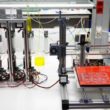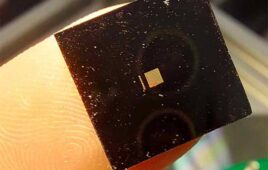
[Image from Wikipedia
The research team demonstrated the effectiveness of growing anal sphincters in a lab to treat an animal model for fecal incontinence. The success comes after the researchers reported success in implanting human-engineered intestines in rodents.
“Results from both projects are promising and exciting,” said Khalil N. Bitar, senior researcher on both projects, in a press release. “Our goal is to use a patient’s own cells to engineer replacement tissue in the lab for devastating conditions that affect the digestive system.”
The newly engineered sphincters were designed to treat passive incontinence that comes from a weakened ring-like muscle. The muscle can lose its function with age or can be damaged at child birth or with certain types of surgery. Currently, the options to fix it come with high complication rates and limited success. It is usually repaired with skeletal muscle grafts, injectable silicone material or by implanting mechanical devices.
“The regenerative medicine approach has a promising potential for people affected by passive fecal incontinence,” said Bitar. “These patients face embarrassment, limited social activities leading to depression and, because they are reluctant to report their condition, they often suffer without help.”
Wake Forest has been pioneering regenerative medicine recently by turning scientific discovery into clinical therapies. They were one of the first institutions in the world to grown organs in a lab that could be transplanted into a human.
Bitar’s research team was one of the first teams to report lab-grown anal sphincters that were bioengineered from human cells and implanted into immune-suppressed rodents in 2011. The new research treated 20 rabbits with fecal incontinence. Eight of the rabbits were treated using sphincters engineered using their own muscle and nerve cells, eight were not treated and four had a sham surgery.
The sphincters were created using small biopsies from each animals’ sphincter and intestinal tissue, according to the researchers. Using that tissue, the researchers isolated smooth muscle and nerve cells to multiply them in a lab. A ring-shaped mold was used to later the two types of cells together to build the new sphincter in a process that took four to six weeks.
The animals who received the sphincters experienced fecal continence within the three month follow-up period. The other groups saw no improvements. Sphincter pressure measurements also showed that the new sphincters were viable and functional while maintaining muscle and nerve components.
The other project that Bitar and his team worked on was designed to help people who have intestinal failure that occurs when the small intestine malfunctions or is too short to be able to digest food and absorb nutrients.
“A major challenge in building replacement intestine tissue in the lab is that it is the combination of smooth muscle and nerve cells in gut tissue that moves digested food through the gastrointestinal tract,” said Bitar.
Bitar’s team used the two different cell types to make sheets of muscle that were pre-wired with nerves. The sheets were wrapped around tubular molds made of chitosan, which is found in shrimp shells and is FDA approved.
The tubular structures were put into rats in two phases. Phase one implanted the tubes in the fatty tissue of the lower abdomen for four weeks, and with plenty of oxygen, the tissue formed blood vessels on the tubes. Muscle cells can also release materials that could replace the scaffold as it degrades. Phase two connected bioengineered tubular intestines to the animals’ intestines like an intestine transplant. It took six weeks for the tubes to develop a cellular lining while epithelial cells moved to the area. Further examination showed that the rats replacement intestine was a healthy color and had digested food.
“Our results suggest that engineered human intestine could provide a viable treatment to lengthen the gut for patients with gastrointestinal disorders, or patients who lose parts of their intestines due to cancer,” said Bitar.
The research was supported by the U.S. Armed Forces, the National Institutes of Health under the Armed Forces Institute for Regenerative Medicine and the National Institute of Diabetes and Digestive and Kidney Diseases. It was published in the journal Stem Cells Translational Medicine.






